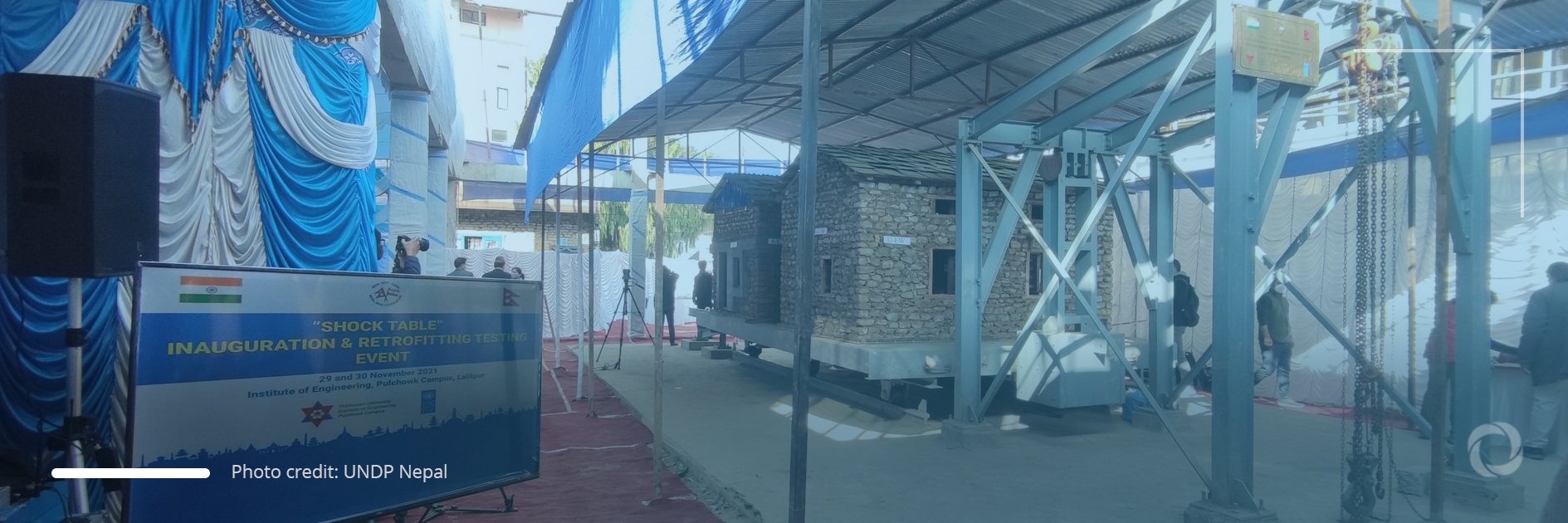Being situated in an earthquake-prone area, on November 29 Nepal unveiled its first shock table facility to allow the assessment of the seismic performance of buildings and structures. More than two million private houses in Nepal are at risk of collapse in case of an earthquake and these could be made safer by using retrofitting technology, experts say.
A 20-ton payload capacity shock table, 6 m x 3.6 m in size, has been constructed by the United Nations Development Programme (UNDP) with funding support from the Government of India (GoI). Built on-premises on the Pulchowk Campus at Tribhuwan University Institute of Engineering (IOE), the facility aims to strengthen the capacity of IOE for research and academic work on safer construction and retrofitting techniques.
Building earthquake resilience
Two half-scale models of one-storey plus attic high buildings have been constructed on the shock table. The models are being tested by UNDP engineers under the guidance of technical experts by progressively increasing impacts such as acceleration being applied to the shock table.
With @IndiaInNepal support, UNDP handed over Shock Table Testing Facility to @IOE_Pulchowk in collab. w/@moudnepal for research & academic work on safer reconstruction and retrofitting techniques. The facility & test demo. was inaugurated by Hon. Minister Ms. @Jhakri_did, MoUD pic.twitter.com/NCM6jXnAjr
— UNDP in Nepal (@UNDPNepal) November 29, 2021
“The shock table testing facility is expected to be instrumental in identifying appropriate retrofitting technologies to make Nepal’s traditional houses safer and resilient,” a statement issued on November 29 by UNDP Nepal reads.
Inaugurating the facility, Ram Kumari Jhakri, Nepal’s Minister for Urban Development, stated that the scientific technology and the academic research it adopts would be helpful in making Nepali homes safer.
“Many of us were born in non-engineered traditional mud-mortar houses like the one that has been put on test here at the shock table. The Government of Nepal (GoN) would provide the necessary support to expand the research facility and its application,” she added.
Karun Bansal, First Secretary for Development Projects and Reconstruction at the Embassy of India in Kathmandu, hoped that the facility, which is part of the larger post-earthquake support provided by India to Nepal, would help to strengthen the capacity of the GoN in building earthquake resilience.
GoI, UNDP reconstruction support
Over the centuries, Nepal has faced a series of devastating earthquakes. The latest occurred in 2015, killing about 9,000 people and injuring almost 22,000. Whole villages were smashed across the country leaving hundreds of thousands of Nepalese homeless and the GoI was among the first to provide support. As part of the reconstruction process initiated after the 2015 earthquake, over 50,000 private houses have been constructed in the Gorkha and Nuwakot districts of Nepal with funding from the GoI. In March 2018, the GoI engaged UNDP and UNOPS to provide socio-technical facilitation and consultation services to these 50,000 earthquake-affected households. Furthermore, India committed US$150 million as a post-earthquake assistance package for the housing sector to provide financial and technical support for reconstruction for 50,000 beneficiaries. Of this amount, US$100 million was granted.

